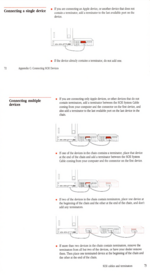I think you're confusing the
logical structure of the bus (where the Mac is at the top and everything else is underneath it) with the
electrical structure of the bus (where the Mac is just another device with two scsi cables connected to it). Termination is not about SCSI as a data protocol, it's about how the electrical signals themselves travel down the wires, so it's where the wires go that matters, not what devices are talking to what. You terminate the points where the bus cables stop.
Think of the chain like this:
[internal drives] <-> [mac logic board] <-> [external drives]
The Mac is in the
middle of the chain, not at one of the ends. The bus doesn't end there, it passes through. So the Mac is just a SCSI device with two ports like any other. The "ends" of the bus are the devices that only have one cable plugged in; the middles are devices with two cables plugged in.
So, essentially:
- If you only have an internal drive, the internal drive needs a terminator; the Mac can deal with the termination of the other end of the bus because it's at the end. ([internal drive] <-> [mac logic board]).
- If you only have an external drive, the external drive needs a terminator, the Mac can deal with the other end ([mac logic board] <-> [external drive])
- If you have both, you need to terminate both ends; the Mac is no longer at one of the ends of the bus, so it can't terminate anything ([internal drive] <-> [mac logic board] <-> [external drive])
- If you have more than one on the internal or the external bus, you terminate the last one on each end.
This is literally about where the cables stop. Nothing more, nothing less. If the cable doesn't stop, adding termination there won't help and may cause harm.
And obviously this doesn't apply in quite the same way for Macs that have two distinct SCSI buses for internal and external.


